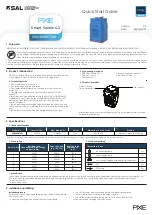
Balluff Network Interface
www.balluff.com
2
The 10/100Base-TX and 100Base-FX/BX Connectors
The 10/100Base-TX Connections
The following lists the pinouts of 10/100Base-TX ports.
Pin
Regular Ports
Uplink port
1
Output Transmit Data +
Input Receive Data +
2
Output Transmit Data -
Input Receive Data -
3
Input Receive Data +
Output Transmit Data +
4
NC
NC
5
NC
NC
6
Input Receive Data -
Output Transmit Data -
7
NC
NC
8
NC
NC
The 100Base-FX Connections
The fiber port pinouts
The Tx (transmit) port of device I is connected to the Rx (receive)
port of device II, and the Rx (receive) port of device I to the Tx
(transmit) port of device II.
The WDM 100Base-BX Connections
The fiber port pinouts
Only one Single mode or Multi mode optical fiber is required to
transmit and receive data.
The 100Base-FX/BX SFP Socket Connections
The SFP socket for fiber optic expansion.
Functional Description
Meets EN61000-6-2 & EN61000-6-4 EMC Generic Standard Immunity for
industrial environment.
Supports 802.3/802.3u/802.3x. Auto-negotiation: 10/100Mbps, full/half-duplex.
Auto MDI/MDIX.
100Base-FX: Multi mode/Single mode SC or ST type. 100Base-BX: WDM Multi
mode/Single mode SC type.
SFP socket for fiber optic expansion.
Supports 1024 MAC addresses. Provides 448K bits memory buffer.
Alarms for power and port link failure by relay output 1A @ 250VAC.
Power consumption: 6W Max.
Power Supply: Redundant 12~48VDC Terminal Block power inputs.
-20
°C
to 60
°C
(-4
°F
to 140
°F
) operating temperature range.
Supports DIN-Rail or Panel Mounting installation.
Assembly, Startup, and Dismantling
Assembly: Place the device on the DIN rail from above using the slot. Push the
front of the device toward the mounting surface until it audibly snaps into place.
Startup: Connect the supply voltage to start up the device via the terminal block.
Dismantling: Pull out the lower edge and then remove the device from the DIN
rail.
Nr
.
9
1
4
4
8
6
E
N
E
d
it
io
n
G
1
6
Re
p
la
c
e
s
E
d
it
io
n
J
1
4
Su
b
je
c
t
to
m
o
d
if
ic
a
ti
o
n




















